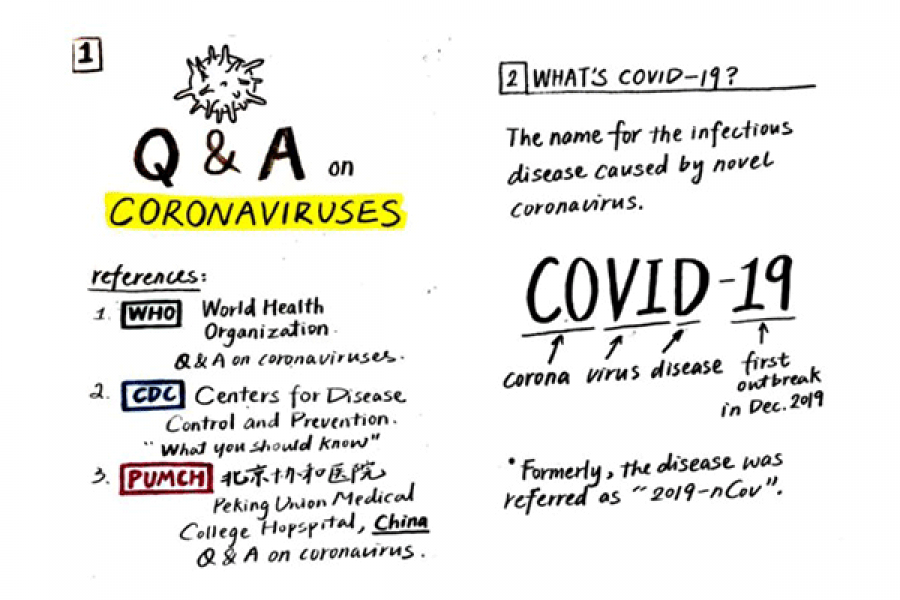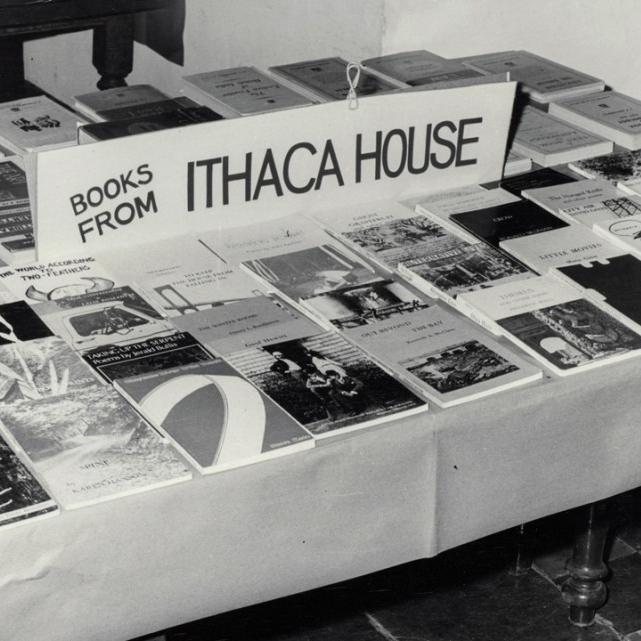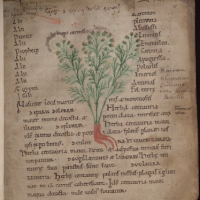Poets, artists, designers and composers at Cornell have found inspiration in the coronavirus era with creative work responding to the challenges of living during a pandemic – including community health, sudden changes to a once-familiar landscape, and separation and connection across social and physical distance.
Many students adapted and even stepped up their game, finding creative ways to continue working.
Art student Patrick Brennan, M.F.A. ’20, offered a thoughtful perspective on being an artist restricted by social distancing. He posted a video featuring 33 works on paper on Instagram, titled “You can make drawings anywhere!”
“The idea of losing our space is the worst,” he wrote, “ but finding ways through adaptive materials and a fluid, stream of conscious[ness] approach, we can keep working. That’s always been the strength of drawing for me – by any means necessary!”
Landscape architecture student Lyuxiao Liu, M.L.A. ’20, spent her last Cornell semester at AAP NYC, the College of Architecture, Art and Planning’s program in New York City. When the city went on lockdown, she captured the sudden change in a sonic diary for a class assignment.
Her sound collage, “032220,” is named for the date New York City’s stay-at-home order went into effect. “It was the day when the city that never sleeps was forced to be settled in an eerie way,” she said.
Landscape architecture student Lyuxiao Liu, M.L.A. ’20, spent her last Cornell semester at AAP NYC. When the city went on lockdown, she captured the sudden change in a sound collage for a class assignment.
To evoke the city’s mood, Liu collected “different sounds and voices that can make up a New Yorker’s world before and after this day,” she said.
Since she had to stay indoors and couldn’t venture out to record sounds, the “work is highly subjective,” she said. “The overall idea is to deliver a picture of a society that was suddenly and profoundly altered by an invisible yet fatal force. Our own voice of mind and the sounds we may not even have noticed before unravel during self-quarantine. When one door closes, another opens.”
Chenglin Zhu ’23, an international student from China, created a four-page info comic of frequently asked questions about coronaviruses, as an assignment for a first-year writing seminar with Jon McKenzie, professor of practice in English in the College of Arts and Sciences (A&S). Zhu used information from the World Health Organization, the Centers for Disease Control and Prevention, and Peking Union Medical College Hospital.
Rachel Prentice, associate professor of science and technology studies in A&S, found her students ready to alter their coursework in the graduate-undergraduate seminar Moving and Knowing.
“I asked students if they would be interested in shifting gears from topics like dance to thinking about moving and knowing in this new moment,” she said. “The responses were hugely enthusiastic.”
After some quick changes to the syllabus, she asked students for weekly personal reflections on their lives. “Their responses were predictably smart, moving and a lovely set of snapshots of what Cornell students are doing and thinking about during this moment of mass social disruption.”
Tina Lam, M.F.A. ’21, an art student in AAP, began a video project in Prentice’s course, then switched to making drawings at home of her video stills.
She wrote: “My parents are genocide refugees from Cambodia. The mere fact that they have landed in Canada has undeniably been the source of wealth in my life; modest cost of housing, good social network, free health care … Now that we are reunited and confined at home, my mom keeps reminding us how humility, resilience and compassion are more constructive in times of crisis than fear and resentment.”
A ‘networked-but-disconnected’ reality
Professor of music Kevin Ernste’s Electroacoustic Composition graduate seminar featured projects “explicitly engaging with our new ‘networked-but-disconnected’ reality,” Ernste said.
The projects ranged from pre-recorded and livestreamed performances to more conceptual work: virtual reality and game environments and audio feedback circulating from one user to another on a network.
Grad student Joshua Biggs built a piece from sounds collected on social media of people sitting quietly in their quarantine spaces. “Others are exploring more interactive performance methods,” Ernste said, “including works sharing live audio or video, or ‘live coding’ – executing musical code together on one remote machine.”
Han Xu, a first-year doctoral student in the seminar, became interested in the sounds of deer, birds and insects on campus after the human population left.
“I felt isolated because everyone just went back home and then there was me,” he said. “To make me happy and try to deal with anxiety, I tried to stay close to nature and walk through campus every day. It was a pretty good experience to hear the animal sounds and see their behavior.”
He recorded them, using coded software for the natural sounds to trigger video, and added electroacoustic sounds.
For his final project, he invited a Buddhist monk to perform another piece, “Etude No. 5,” accompanied by electronic sounds. “With the quarantine situation, I really wanted to do a prayer for the difficulties before the world,” Xu said.
Xu wants to incorporate the animal and landscape sounds he recorded on campus into a piece with a Buddhist choir this summer.
“This is about a network of things; I want to use a virtual concert to demonstrate my concept,” he said. “I believe human beings and non-humans, they negotiate visibility and invisibility in the network.”
Ernste plans to make some of the seminar projects available online.
Catastrophe, grief and absence
“This is precisely the time when artists go to work,” Toni Morrison, M.A. ’55, wrote in 2015 about living “in times of dread.” “There is no time for despair, no place for self-pity, no need for silence, no room for fear. We speak, we write, we do language. That is how civilizations are healed.”
Faculty in the Department of English Creative Writing Program agreed. They will be making video recordings of readings from their own work or another’s “to address the emotions of the times,” program director Helena Maria Viramontes said. “We are in the early stages of planning but deeply feel as writers and poets, we should ‘speak, so that we can heal.’”
Andrew Galloway, the James John Professor of Medieval Studies in A&S, had his students thinking about catastrophe in light of the current pandemic, in a course on Geoffrey Chaucer (ca. 1342-1400), who lived through the Black Death and subsequent waves of plague. Chaucer introduced the word (and the notion of) “tragedy” to the English language.
“He almost certainly saw a lot of death,” Galloway said. At its peak in 1348-49, the plague killed “up to one-third of the [British] population during the summer months, including a whole generation of academics at Oxford and Cambridge.”
The final exam questions for the course included: “What can Chaucer’s poetry teach us about responding to catastrophe, personal or collective?” Among the responses: “Part of me thinks we’re too embedded within our own personal and collective traumas to reflect on catastrophe,” Andrew Nahom ’22 wrote, “but the other part thinks there has never been a better opportunity … there is a personal touch to the subject of plagues.”
In April, Mukoma wa Ngugi, associate professor of English in A&S, published “In Our Times” in the online magazine Warscapes. In the poem, he addresses the way we now experience grief:
“Now / Dying is now truly lonely / no loved ones by your side / or at your wake / In the crematorium / a lone technician cries / Out in the cemetery /all stand six feet apart / to your six feet under / (yes, terrible puns are fact now) / But believe this love / like your god does embrace us all.”
“I was reading about a crematorium and I thought of feeling overwhelmed at someone’s death when we can’t be by each other’s side,” Mukoma said. “At the same time, we have all this tech and we’re Skyping each other while we’re dying.”
The magazine also features “Dawn of Darkness,” a poem by Mukoma’s father, Ngũgĩ wa Thiong’o,written in response to “In Our Times” (and work by two other poets). Father and son are now collaborating on “a long poem in a time of tragedy,” Mukoma said. “For now we’re just enjoying exchanging words.”
Mukoma recently wrapped up an English seminar, Enlightenment: Race, Class, Gender and Violence.
“The students are feeling more involved in the class and consequently doing more than they would have,” he said. “I’ve been so impressed with how they have been able to be fully present and fully engaged – though they’ve been affected too; for some of them, their grandmother or grandfather just died.”
He dedicated the last class to talking about the pandemic.
“They’re seeing the effect of those ideas we’ve been critiquing and relating them to their own personal lives,” he said. “The world is a laboratory for them.”







